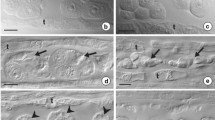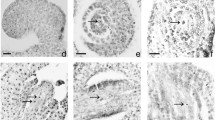Abstract
Chinese narcissus (Narcissus tazetta var. chinensis Roem) blooms but has no seeds. Embryological studies on the species were conducted to discover the causes of its sterility. Its anther wall is composed of four layers of cells, and its tapetum is of the secretory type. The cytokinesis of microspore mother cells is of the successive type, and the tetrad is tetrahedral. During meiosis of microspore mother cells, some chromosomes lagged, and several micronuclei were found in tetrads. Only 27.7% of the pollen grains contained full cytoplasm, and 1.3% of them germinated in culture medium. No pollen grain, however, could germinate on the stigma. The ovary is trilocular with axile placenta, and the ovules are bitegmic, tenuinucellate, and anatropous. Its embryo sac is of the polygonum type. Most embryo sacs degenerated, and only about 4.5% of the ovules contained a normal embryo sac with an egg cell, two synergids, three antipodal, and a central cell containing two polar nuclei. One reason for the sterility of Chinese narcissus is the abnormality of microsporogenesis and megasporogenesis, in which only a few functional pollen grains and embryo sacs are produced. The other reason is that the pollen grains cannot germinate on the stigma.
Similar content being viewed by others
References
Li M. X., Chen D. H., and Wang L. Y., A study on the karyotype and the pattern of Giemsa C-band in Narcissus tazetta var. chinensis, Acta Hort. Sin., 1980, 7: 29–37 (in Chinese)
Zhuang W. J., Lin Z. L. and Su J. W., Karyotypes and Giemsa C-bands of two local cultivars in Narcissus tazetta L. var. chinensis Roem, Fujian J. Agric. Sci., 1999, 14(1): 51–57 (in Chinese)
Chen L. J., Miao Y., Chen D. H. and Tian H. Q., Analysis of germplasm resources of Narcissus tazetta L. var. chinesis by RAPD, J. Xiamen Univ. (Nat. Ed.), 2002, 41(6): 810–814 (in Chinese)
Xu R. Y., A preliminary report on the natural resources of Chinese narcissus, J. Fujian Agric. Coll., 1987, 16(2): 160–164 (in Chinese)
Lu L. X., Chen X. J., Yu X. L. and Chen J. L., Fundamental studies on breeding of resources of narcissus cultivars, J. Fujian Agric. Coll., 1989, 18: 31–36 (in Chinese)
Tseng C. J. and Chen Q. N., Studies on chromosome numbers and nomenclature of Narcissi in Zhangzhou, Fujian Bull. Bot. Res., 1984, 4: 159–163 (in Chinese)
Fernandes A., On the role of triploidy in the development of the section bulbocodii dc. of the genus NarcissusL, Bol. Soc. Broter., 1987, 60: 273–322
Brandham P. E. and Kirton P. R., The chromosomes of species hybrids and cultivars of Narcissus L, Kew Bull., 1987, 42: 65–102
Brandham P. E., Evolution of polyplody in cultivated Narcissussubgenes, Genetica, 1986, 68: 161–168
Wang L. Y., Qin K. J. and Li M. X., Meiosis of pollen mother cells and development of pollen in Chinese sacred Lily (Narcissus tazetta var. chinesis Roem), J. Beijing For. Coll., 1984, 2: 78–81 (in Chinese)
Author information
Authors and Affiliations
Corresponding author
Additional information
This paper was translated from Journal of Xiamen University (Natural Science), 2005, 44(1) (in Chinese)
Rights and permissions
About this article
Cite this article
Ge, L., Wu, J., Chen, L. et al. Embryological Studies on Narcissus tazetta var. chinensis . Front. Biol. China 1, 18–22 (2006). https://doi.org/10.1007/s11515-005-0007-2
Issue Date:
DOI: https://doi.org/10.1007/s11515-005-0007-2




